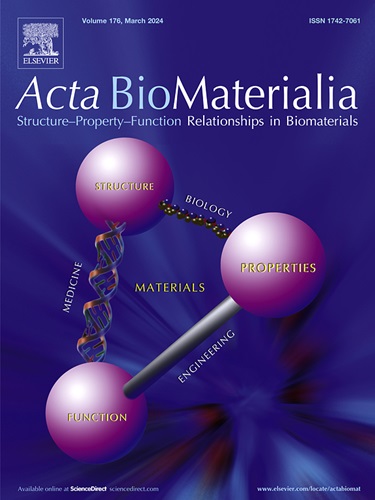Engineered macrophage membrane-coated nanoparticles attenuate calcium oxalate nephrocalcinosis-induced kidney injury by reducing oxidative stress and pyroptosis
IF 9.4
1区 医学
Q1 ENGINEERING, BIOMEDICAL
引用次数: 0
Abstract
Kidney stones are characterized by a high incidence and recurrence rate, leading to kidney injury, which in turn accelerates stone formation and deposition. Increasing evidence have demonstrated that oxidative stress and cell pyroptosis play important role in the calcium oxalate (CaOx) stones induced kidney injury. Currently, treatments related to oxidative stress and inflammation associated with kidney stones are still relatively limited. Here, we designed engineered macrophage cell membrane-coated hollow mesoporous manganese dioxide nanoparticles loaded with NLRP3 inhibitors Mcc950 (KM@M@M). KM@M@M NPs were modified with Kim-1 targeting peptides on M2-polarized macrophage membranes to achieve better targeted delivery to injured kidney tubules. Compared with traditional drugs, KM@M@M NPs reduce systemic toxicity through targeted drug delivery to the kidneys. In vivo and in vitro results demonstrate that KM@M@M NPs reduces the activation of the NLRP3 inflammasome in renal tubular epithelial cells by scavenging ROS, thereby downregulating gasdermin D cleavage and the production of inflammatory cytokines, ultimately inhibiting cell pyroptosis. In addition, bioinformatic analysis revealed that KM@M@M NPs protect against CaOx induced kidney injury via suppressing the NLRP3/GSDMD pathway. This article extending the application of engineered cell membrane-based biomimetic nanotechnology, and providing a promising strategy for dual protection in CaOx stones induced kidney injury.
Statement of significance
Currently, apart from invasive surgery, there are few pharmacological therapies for CaOx-induced renal injury. This study presents a new strategy using engineered macrophage cell membrane-coated hollow mesoporous manganese dioxide nanoparticles (KM@M@M) to target and treat calcium oxalate (CaOx)-induced kidney injury. The nanoparticles effectively scavenge reactive oxygen species (ROS) and inhibit NLRP3 inflammasome activation, preventing pyroptosis and kidney damage. By delivering NLRP3 inhibitors directly to injured renal tubules, KM@M@M NPs reduce inflammation and stone deposition. This work demonstrates the potential of biomimetic nanotechnology for targeted treatment, offering a promising approach to prevent CaOx-induced renal injury and enhance therapeutic outcomes in kidney stone disease.

求助全文
约1分钟内获得全文
求助全文
来源期刊

Acta Biomaterialia
工程技术-材料科学:生物材料
CiteScore
16.80
自引率
3.10%
发文量
776
审稿时长
30 days
期刊介绍:
Acta Biomaterialia is a monthly peer-reviewed scientific journal published by Elsevier. The journal was established in January 2005. The editor-in-chief is W.R. Wagner (University of Pittsburgh). The journal covers research in biomaterials science, including the interrelationship of biomaterial structure and function from macroscale to nanoscale. Topical coverage includes biomedical and biocompatible materials.
 求助内容:
求助内容: 应助结果提醒方式:
应助结果提醒方式:


